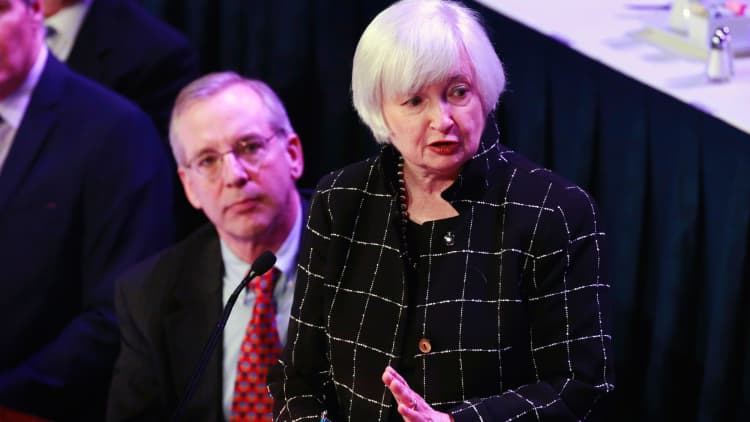
Two important trends that have helped propel the stock market are coming to an end, posing significant challenges for investors, according to Wall Street experts.
One is a near-term pattern — namely the rush to cover short positions that has driven the more than 13 percent off its Feb. 11 intraday low. JPMorgan Chase's models show that short covering is running out of gas.
The other is longer term — namely the oft-cited "Fed put," or the backstop traders believe has come from the U.S. central bank's easy monetary policy. Strategists at Bank of America Merrill Lynch see a pattern in which the riskiest stocks that benefit the most from Fed policy are now underperforming their higher-quality peers.
Both JPMorgan and BofAML agree on one element of strategy: The shift should be on from momentum to value stocks as the rally stumbles. Major averages were down nearly 1 percent across the board in Thursday trading.
"We think this recovery has been largely driven by fundamentally insensitive strategies and broad-based short covering," Dubravko Lakos-Bujas, JPMorgan's head of U.S. equity strategy, and others said in a note to clients. Models the firm uses to monitor market trends imply "little room left for further short covering" while trend followers "have covered most of their shorts and are currently close to being neutral equities."
If the analysis holds that the rally has been fueled largely by position shifts and not fundamentals, then it comes at a perilous time.
Wall Street is heading into a first-quarter earnings season that promises to be ugly, with FactSet estimating aggregate S&P 500 earnings to decline 8.5 percent. It would be the worst three-month period since the third quarter of 2009 and the first time the index had shown four consecutive quarters of decline in seven years.
While much of the blame has been put on energy, which is expected to show a drop of 101.8 percent from the year-earlier period, even excluding the sector produces an expected decline of 3.7 percent, FactSet reported. Just three of the index's 10 sectors are expected to show growth.
Economic fundamentals also are deteriorating.
Gross domestic product grew just 1.4 percent in the fourth quarter and is expected to rise an even more anemic 0.4 percent in the first quarter, according to the Atlanta Fed's tracker. With little earnings or economic growth to serve as a tail wind, the market's path higher will be difficult.
"With most of the technical factors having already run their course and with equity valuation at elevated levels, we believe a reacceleration in earnings growth and weaker (U.S. dollar) are needed to warrant a more constructive view on U.S. equities," Lakos-Bujas said. "The fundamental backdrop remains challenged."
Normally the market then would look to the Fed for some type of policy help to keep the rally going.
However, the central bankers are left with little else to do but jawbone a relatively dovish stance after hiking rates a quarter-point in December — the first such move in more than nine years — then electing not to move at either the January or March Federal Open Market Committee meetings. Traders assign virtually no chance of a hike at the April 26-27 FOMC meeting, and in fact don't see a better than 50 percent of a move until December, according to CME data.
Confidence is waning that even the markedly dovish tone from Chair Janet Yellen and her fellow policymakers will help sustain the recent rally.
"Will the Fed/central bank put continue to drive risk assets higher? We are skeptical," Savita Subramanian, equity and quant strategist at Bank of America Merrill Lynch, and others said in a note. "We see diminishing returns to risky stocks from (quantitative easing) ... (and) the impact of Fed dovishness is similarly waning: the risk rally in late March on Yellen's dovish tone was one of the smallest we have seen since 2014."
Companies with strong balance sheets have outperformed low quality by 7 percentage points so far in 2016, Subramanian said.
"High-quality stocks are still cheap, underowned, fundamentally attractive, and a good hedge against volatility and market downturns, in our view," she said.






